admin
Staff member
We all know that riding a motorcycle is one of the best feelings in the world. It can be rolling meditation as you cruise down the winding mountain roads, at the same time that it can be one of the greatest thrills as you balance on the very edge of adhesion in a 45 degree lean at the track. However, both extreme ends of the riding spectrum are tied together by one very important thing to think about: How to keep the rider (namely, you) safe.
That is why we have helmets, armored jackets and pants, gloves with knuckle guards and boots that can take a bruising. Manufacturers, both of the gear and the bikes themselves, are also not resting on their laurels, and both technology and materials have advanced so much that if you were to compare a jacket from the year 2000 to one from 2023, they would bear little to no similarity. It is these advances that are making motorcycle riding safer, and giving riders ever improving chances of surviving unfortunate incidents with minimalised injuries.
Today, we’ll take a look at the five most prominent areas of advancement, both in riding gear and motorcycle tech, that are making things safer bikers, especially given the risks and dangers that motorcyclists face on the road. Of course, you still need to ride defensively and keep your head on a swivel, as tech and materials can only do so much and it is still down to the rider to actually control the bike!
It is fair to say that the most important piece of motorcycle safety gear of all is the helmet. Just taking a look at the motorcycle safety stats for the state of Georgia, motorcycles have become much more popular and, consequently, there have been more crashes and unfortunate fatalities. For 2019, there were 3,948 crashes, with 179 fatalities, a startling 4.5% fatality rate. However, in those crashes, a properly fitted and modern helmet can reduce chances of fatalities by 42%, and reduce the chances of serious head injuries by 69%.
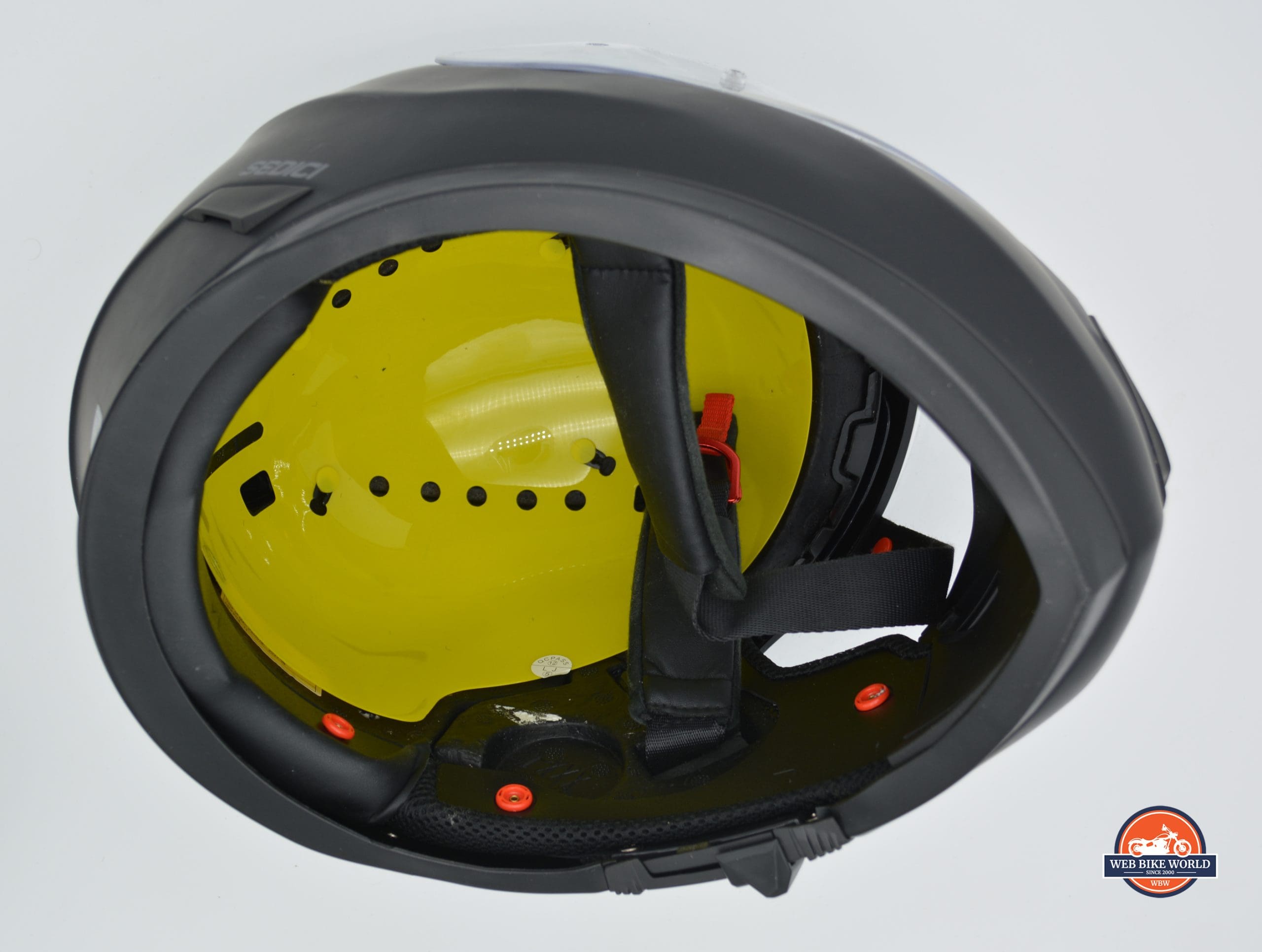

From our review of the Sedici Strada II MIPS helmet, the MIPS technology allows for gentle acceleration of the brain to prevent TBI’s and shock/concussion injuries.
Part of this is that many new technologies have appeared in helmets in the past 5 years. The most significant of these has been MIPS, or Multi-directional Impact Protection System, a sliding layer between the liner and the EPS foam inside a helmet that moves enough to slow down brain acceleration inside your skull, preventing impact related concussions and traumatic brain injuries. New shell material compositions with new synthetic and organic fibers, and new ways of mixing carbon composites, have drastically improved energy dissipation and absorption. New EPS technologies, including crush structures such as Koroyd, have pushed helmets even further, to the point that a side by side comparison with a helmet even 8 to 10 years ago would make the older helmet look dangerous to wear.
It used to be that if you wanted motorcycle armor, you had to pay a premium for it, or get something like a race suit with sliders and armor built in. How things have changed over the decades!
In 2023, you can get gear that not only has armor built in, but it has various types of that armor. While TPU is still the de-facto standard, you can also get non-Newtonian impact foams, energy dispersion materials, and even some of the actual fibers used in jackets and pants can take some of the energy out of any impact. These fibers are commonly DuPont Kevlar or organic aramid latticeworks, as well as new polyester hybrid materials that dissipate heat and abrasion far better than even a half decade ago.
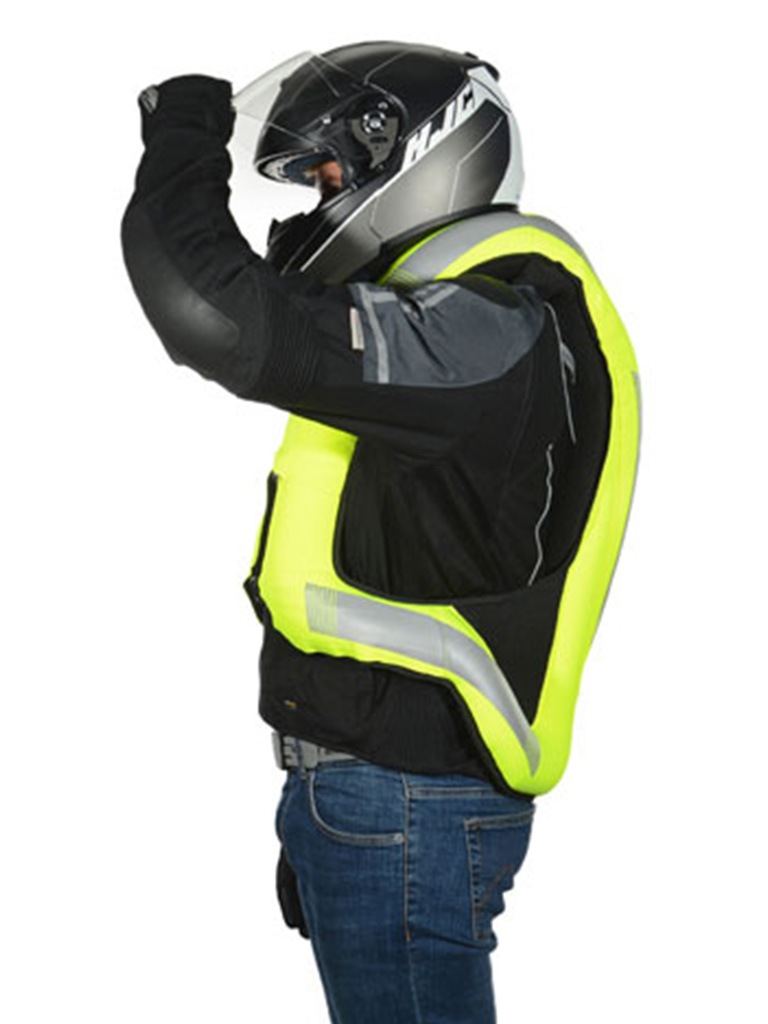

As can be seen with this Helite Turtle II airbag vest, when deployed, it provides lateral support for the helmet, prevents the helmet from snapping backwards, and provides a full neck to tailbone area of protection. Image via Helite
Perhaps the biggest and most recent push, apart from armor types, is that motorcycle airbag technology is becoming more prominent. It has even advanced to the point that powersports racers in World Superbike, Moto GP, British Superbikes, and the Isle of Man TT races wear airbag equipped race suits, often with the airbag systems from Alpinestars or Dainese built in. This tech has trickled down to regular street riding, with other companies like Helite and Hit-Air leading the charge.
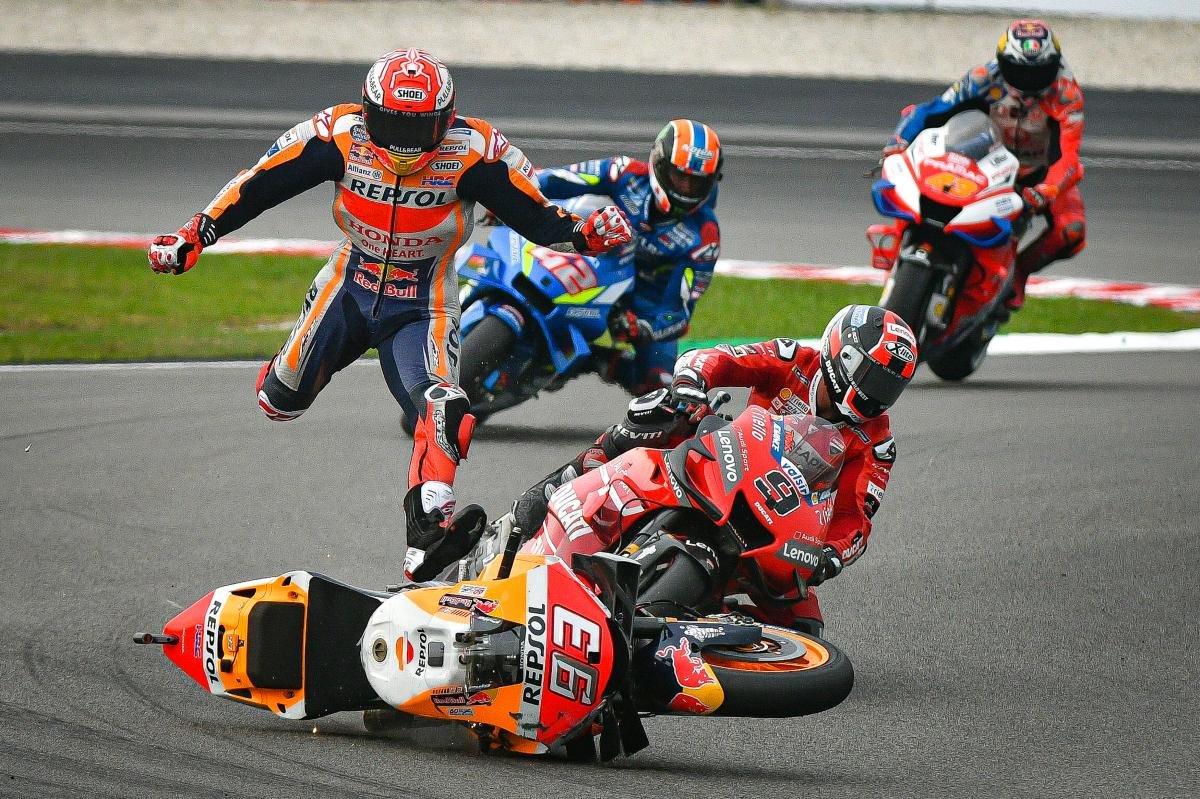

In MotoGP, World SBK, British Superbike, and pretty much any racing powersports, airbag suits are now mandatory. Here you can see one in action, deploying mere moments after Marc Marquez departed company with his Honda in a vicious highside. Image via MotoGP Official Twitter Account
In fact, according to the European Enhanced Vehicle-Safety Committee (EEVC), after extensive research into real accidents where airbags were present versus others where there were no airbags, there is a significant reduction of risk and injuries for the riders wearing airbag vests. With many of them now falling below $700, they are also more affordable than ever, and are well worth the investment.
Put simply, visibility is a critical factor in motorcycle safety, especially in low-light conditions. Verified research from organizations like the Insurance Institute for Highway Safety (IIHS) emphasizes the role of visibility in preventing accidents involving motorcycles, as the most common claim by drivers or other riders that cause or are involved in collisions is “I didn’t see them!” In response to these claims, and after conducting studies on what works the best, many motorcycle equipment manufacturers have introduced new features to enhance rider visibility. Many motorcycle manufacturers themselves have also worked with such industry research partners to improve overall bike visibility as well.
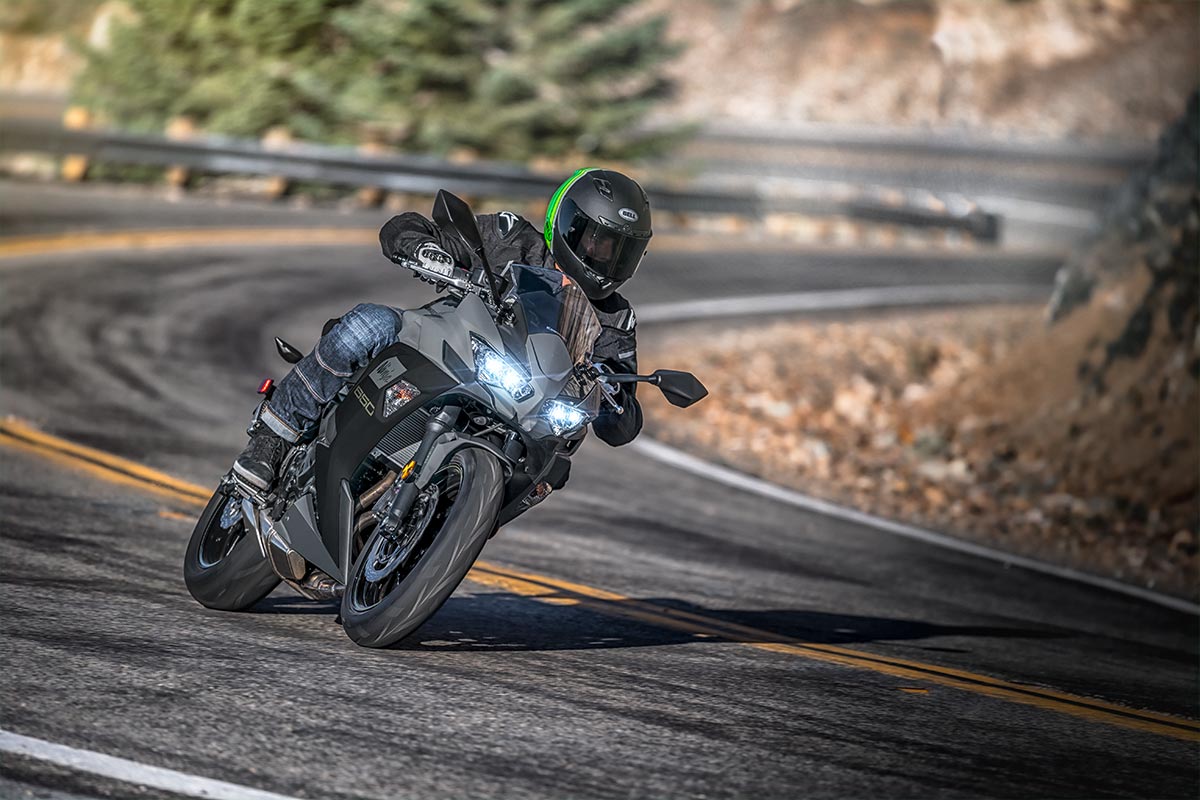

Many manufacturers, such as Kawasaki with the Ninja 650 shown here, are equipping their bikes with LED headlights, making them very prominent even in full daylight. Image via Kawasaki
The most prominent use in motorcycles is the use of LED lighting. More energy efficient, more resilient, and much brighter than standard lights, LEDs in things like headlights, indicators, side lights, and tail lights have increased visibility tenfold. For gear, industry leaders like 3M, partnered with companies like Klim, Alpinestars, Scorpion, and the like have been constantly developing reflective materials that will catch light from any angle and reflect it back, making riders much more conspicuous to other road users.
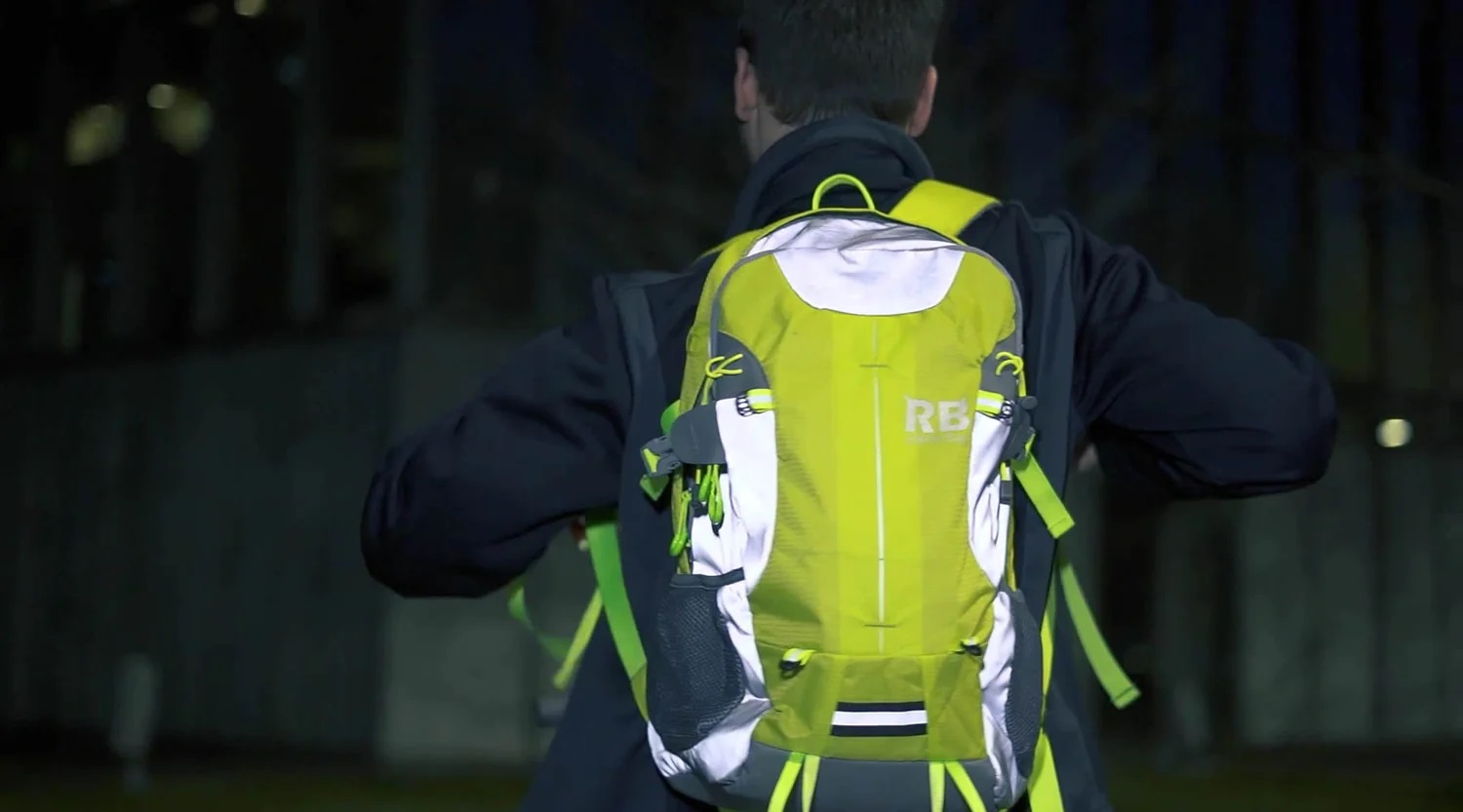

Gear such as this RiderBag USA ultra-high-visibility backpack include large reflective panels to catch light from any angle and reflect it in every direction. Image via RiderBag USA
These reflective materials have also become much more “stealth” when in daytime conditions, to the point that a jacket that looks normal in daylight can light up like a Christmas tree when even a flashlight is shone towards it at night! According to multiple independent studies, these newer and more reflective materials have significantly improved visibility of riders and bikes to other road users, and reduced the likelihood of what many call “SMIDSY (Sorry Mate, I Didn’t See You) collisions.”
Up until the late 2000’s, anti-lock braking on a motorcycle was pretty much relegated to the absolute top of the line bikes. Then, companies such as Honda, BMW, and Aprilia all worked to bring what was an out of reach bit of safety technology to the common man. From those efforts, we received Honda’s Rider Safety Systems, BMW’s ABS Pro, and Aprilia’s Performance Ride Control.
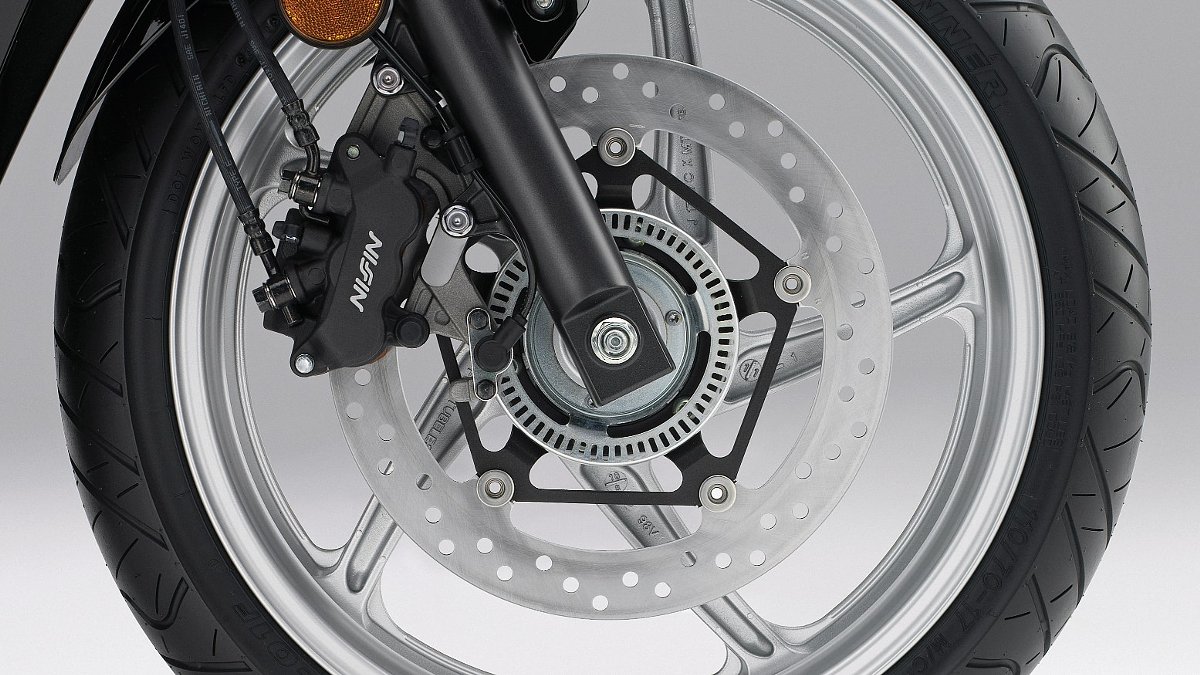

The front brakes of Honda motorcycle, with the ABS ring at the center. Image via RevZilla
Fast forward to the mid-2010’s, and the adoption of the technology was so wide across the motorcycle landscape that ABS was considered a standard, not an option, and the safety systems were starting to focus more on stability control, cornering ABS, and traction control. There have been multiple significant advances, including the introduction of such tech as a six-axis inertial measurement unit (IMU), multiple traction and engine maps, rider modes for different surface conditions, and braking systems that can activate ABS even in a high speed lean without flipping you off in a high-side.
As technology improves, so do the sensors, and it’s not uncommon these days to find not only a primary sensor such as an IMU, but also a backup sensor for redundancy. This is thanks to miniaturization of circuits, as well as significantly reduced manufacturing costs as these safety systems have become standardized across the industry.
This is perhaps the newest area of safety technology currently in 2023 and 2024. While the idea of Bluetooth comms units is not new, integration of them into the sensor suite of a motorcycle is. Honda is leading the charge with this, by bringing a technology from their automotive safety department to their powersports side. Using the riders’ smartphone, Bluetooth comms unit, and an integrated Bluetooth sensor in the bike itself, the bike itself can detect if a crash has happened, and evaluate what response to activate based on the connectivity and positioning of all three connection points.
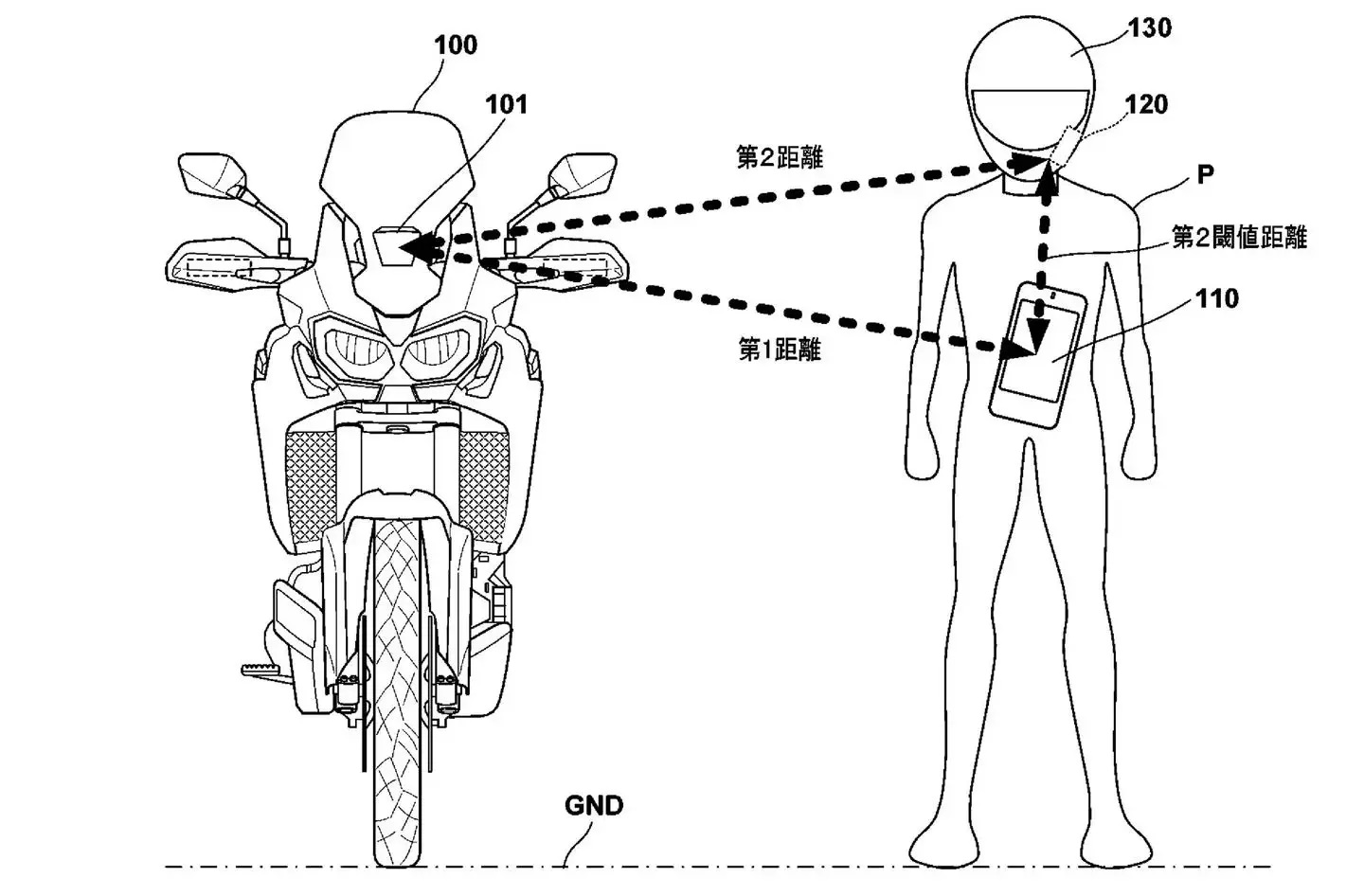

From Honda’s patent filing in Japan for the crash detection system, the Bluetooth comms unit and the smartphone are both connected to the bike. This is the “Normal” position, meaning no emergency. Image via MotorFreaks
For example, if it’s a low speed tip over, and the phone and helmet comms unit are upright and within range, nothing happens. If it’s a high speed crash, the helmet comms unit is distant from the smartphone, and both are outside of 10 feet from the bike, it will automatically send out an SOS via the smartphone. With bikes now also starting to integrate LTE and 5G into their control units and dashes, this technology will likely also be able to use those signals to send out an SOS as well.
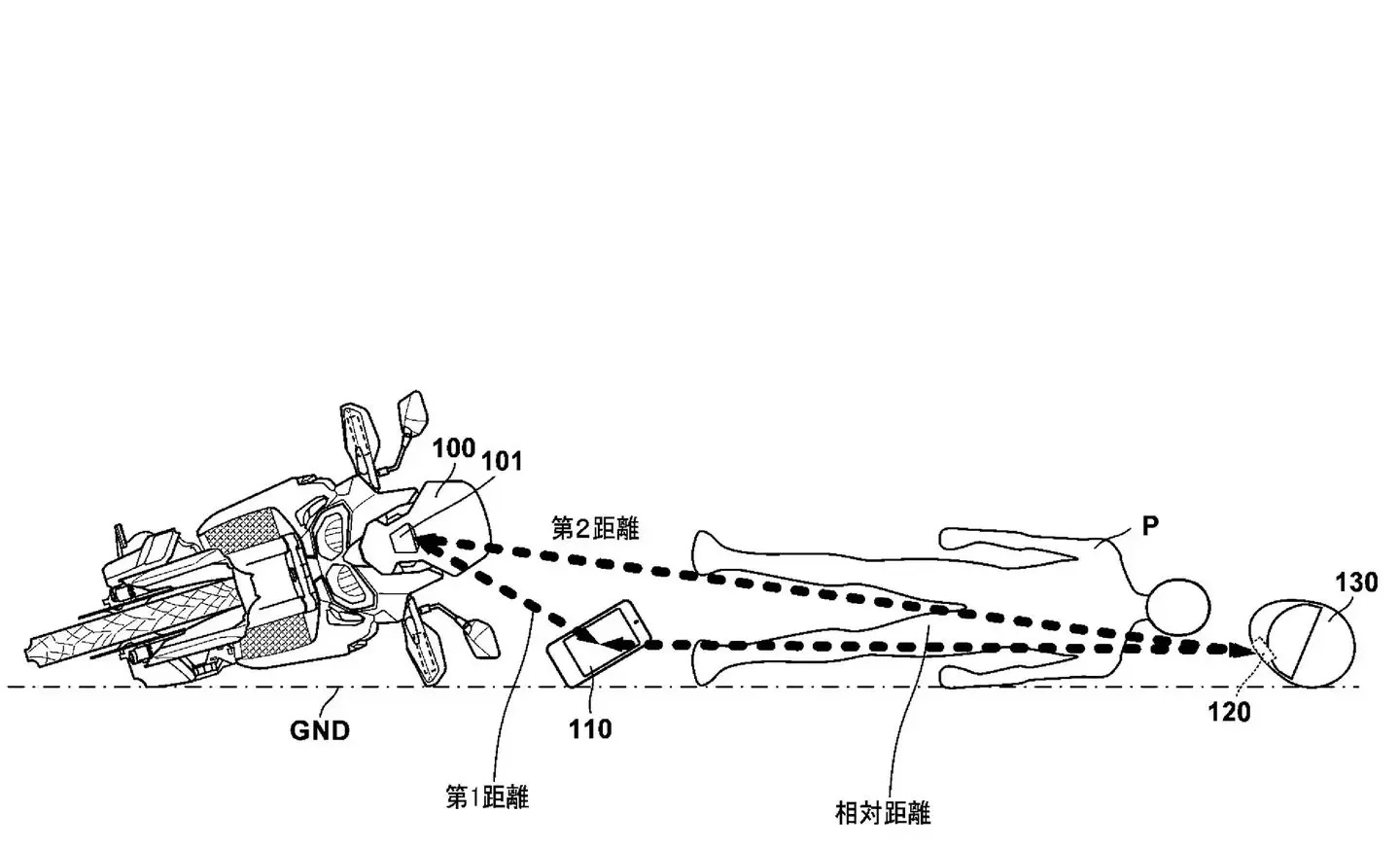

The same Honda crash detection system, this time in an “Urgent” situation. The bike has crashed, the smartphone has separated from the rider, and the helmet is also separated by a long distance from both phone and bike, triggering an automatic SOS call. Image via MotorFreaks
Of course, this is just a support system to the human factor. Bluetooth comms units have also significantly improved in connectivity range and clarity of signal, meaning if you’re the lead rider of a group and someone has an incident in the middle of the pack, newer “mesh-type” comms units can relay that information almost a mile up the road. “Person 10 has crashed!” coming over the system means the lead rider is both A) aware of the incident and B) can pull the group safely over or even off the road into a parking lot and organize emergency response, if any is needed.
As you can see from above, two decades into the millennium we, as a community, are already far safer than when 1999 turned into 2000. Newer materials, better helmets, better energy absorbing materials and armor, better motorcycle safety systems, and new ways to integrate existing tech to boost safety are just five of several hundred ways that riding these days is safer than ever.
However, the human factor is still the ultimate decider in rider safety. Keep your mind on riding, keep your eyes scanning, ride within your limits, and install an “idiot filter” between your brain and right wrist. You don’t need to weave between traffic, you don’t need to ride like the road is your own personal racetrack. If you want to go fast on a race track… then go fast on a race track, not the road. Technology can advance as far as it can, and it is still the human operator that is the ultimate safety system.
Basically, keep two wheels down and ride safe!
The post 5 Ways Motorcycle Equipment Is Improving Rider Safety appeared first on webBikeWorld.
Continue reading...
That is why we have helmets, armored jackets and pants, gloves with knuckle guards and boots that can take a bruising. Manufacturers, both of the gear and the bikes themselves, are also not resting on their laurels, and both technology and materials have advanced so much that if you were to compare a jacket from the year 2000 to one from 2023, they would bear little to no similarity. It is these advances that are making motorcycle riding safer, and giving riders ever improving chances of surviving unfortunate incidents with minimalised injuries.
Today, we’ll take a look at the five most prominent areas of advancement, both in riding gear and motorcycle tech, that are making things safer bikers, especially given the risks and dangers that motorcyclists face on the road. Of course, you still need to ride defensively and keep your head on a swivel, as tech and materials can only do so much and it is still down to the rider to actually control the bike!
Advanced Helmet Technologies
It is fair to say that the most important piece of motorcycle safety gear of all is the helmet. Just taking a look at the motorcycle safety stats for the state of Georgia, motorcycles have become much more popular and, consequently, there have been more crashes and unfortunate fatalities. For 2019, there were 3,948 crashes, with 179 fatalities, a startling 4.5% fatality rate. However, in those crashes, a properly fitted and modern helmet can reduce chances of fatalities by 42%, and reduce the chances of serious head injuries by 69%.


From our review of the Sedici Strada II MIPS helmet, the MIPS technology allows for gentle acceleration of the brain to prevent TBI’s and shock/concussion injuries.
Part of this is that many new technologies have appeared in helmets in the past 5 years. The most significant of these has been MIPS, or Multi-directional Impact Protection System, a sliding layer between the liner and the EPS foam inside a helmet that moves enough to slow down brain acceleration inside your skull, preventing impact related concussions and traumatic brain injuries. New shell material compositions with new synthetic and organic fibers, and new ways of mixing carbon composites, have drastically improved energy dissipation and absorption. New EPS technologies, including crush structures such as Koroyd, have pushed helmets even further, to the point that a side by side comparison with a helmet even 8 to 10 years ago would make the older helmet look dangerous to wear.
Armor, Airbags, & Impact Absorbing Materials
It used to be that if you wanted motorcycle armor, you had to pay a premium for it, or get something like a race suit with sliders and armor built in. How things have changed over the decades!
In 2023, you can get gear that not only has armor built in, but it has various types of that armor. While TPU is still the de-facto standard, you can also get non-Newtonian impact foams, energy dispersion materials, and even some of the actual fibers used in jackets and pants can take some of the energy out of any impact. These fibers are commonly DuPont Kevlar or organic aramid latticeworks, as well as new polyester hybrid materials that dissipate heat and abrasion far better than even a half decade ago.


As can be seen with this Helite Turtle II airbag vest, when deployed, it provides lateral support for the helmet, prevents the helmet from snapping backwards, and provides a full neck to tailbone area of protection. Image via Helite
Perhaps the biggest and most recent push, apart from armor types, is that motorcycle airbag technology is becoming more prominent. It has even advanced to the point that powersports racers in World Superbike, Moto GP, British Superbikes, and the Isle of Man TT races wear airbag equipped race suits, often with the airbag systems from Alpinestars or Dainese built in. This tech has trickled down to regular street riding, with other companies like Helite and Hit-Air leading the charge.


In MotoGP, World SBK, British Superbike, and pretty much any racing powersports, airbag suits are now mandatory. Here you can see one in action, deploying mere moments after Marc Marquez departed company with his Honda in a vicious highside. Image via MotoGP Official Twitter Account
In fact, according to the European Enhanced Vehicle-Safety Committee (EEVC), after extensive research into real accidents where airbags were present versus others where there were no airbags, there is a significant reduction of risk and injuries for the riders wearing airbag vests. With many of them now falling below $700, they are also more affordable than ever, and are well worth the investment.
Enhanced Visibility Features
Put simply, visibility is a critical factor in motorcycle safety, especially in low-light conditions. Verified research from organizations like the Insurance Institute for Highway Safety (IIHS) emphasizes the role of visibility in preventing accidents involving motorcycles, as the most common claim by drivers or other riders that cause or are involved in collisions is “I didn’t see them!” In response to these claims, and after conducting studies on what works the best, many motorcycle equipment manufacturers have introduced new features to enhance rider visibility. Many motorcycle manufacturers themselves have also worked with such industry research partners to improve overall bike visibility as well.


Many manufacturers, such as Kawasaki with the Ninja 650 shown here, are equipping their bikes with LED headlights, making them very prominent even in full daylight. Image via Kawasaki
The most prominent use in motorcycles is the use of LED lighting. More energy efficient, more resilient, and much brighter than standard lights, LEDs in things like headlights, indicators, side lights, and tail lights have increased visibility tenfold. For gear, industry leaders like 3M, partnered with companies like Klim, Alpinestars, Scorpion, and the like have been constantly developing reflective materials that will catch light from any angle and reflect it back, making riders much more conspicuous to other road users.


Gear such as this RiderBag USA ultra-high-visibility backpack include large reflective panels to catch light from any angle and reflect it in every direction. Image via RiderBag USA
These reflective materials have also become much more “stealth” when in daytime conditions, to the point that a jacket that looks normal in daylight can light up like a Christmas tree when even a flashlight is shone towards it at night! According to multiple independent studies, these newer and more reflective materials have significantly improved visibility of riders and bikes to other road users, and reduced the likelihood of what many call “SMIDSY (Sorry Mate, I Didn’t See You) collisions.”
Motorcycle ABS, Stability, & Traction Control Advances
Up until the late 2000’s, anti-lock braking on a motorcycle was pretty much relegated to the absolute top of the line bikes. Then, companies such as Honda, BMW, and Aprilia all worked to bring what was an out of reach bit of safety technology to the common man. From those efforts, we received Honda’s Rider Safety Systems, BMW’s ABS Pro, and Aprilia’s Performance Ride Control.


The front brakes of Honda motorcycle, with the ABS ring at the center. Image via RevZilla
Fast forward to the mid-2010’s, and the adoption of the technology was so wide across the motorcycle landscape that ABS was considered a standard, not an option, and the safety systems were starting to focus more on stability control, cornering ABS, and traction control. There have been multiple significant advances, including the introduction of such tech as a six-axis inertial measurement unit (IMU), multiple traction and engine maps, rider modes for different surface conditions, and braking systems that can activate ABS even in a high speed lean without flipping you off in a high-side.
As technology improves, so do the sensors, and it’s not uncommon these days to find not only a primary sensor such as an IMU, but also a backup sensor for redundancy. This is thanks to miniaturization of circuits, as well as significantly reduced manufacturing costs as these safety systems have become standardized across the industry.
Connectivity With Comms Units & Motorcycle Sensors
This is perhaps the newest area of safety technology currently in 2023 and 2024. While the idea of Bluetooth comms units is not new, integration of them into the sensor suite of a motorcycle is. Honda is leading the charge with this, by bringing a technology from their automotive safety department to their powersports side. Using the riders’ smartphone, Bluetooth comms unit, and an integrated Bluetooth sensor in the bike itself, the bike itself can detect if a crash has happened, and evaluate what response to activate based on the connectivity and positioning of all three connection points.


From Honda’s patent filing in Japan for the crash detection system, the Bluetooth comms unit and the smartphone are both connected to the bike. This is the “Normal” position, meaning no emergency. Image via MotorFreaks
For example, if it’s a low speed tip over, and the phone and helmet comms unit are upright and within range, nothing happens. If it’s a high speed crash, the helmet comms unit is distant from the smartphone, and both are outside of 10 feet from the bike, it will automatically send out an SOS via the smartphone. With bikes now also starting to integrate LTE and 5G into their control units and dashes, this technology will likely also be able to use those signals to send out an SOS as well.


The same Honda crash detection system, this time in an “Urgent” situation. The bike has crashed, the smartphone has separated from the rider, and the helmet is also separated by a long distance from both phone and bike, triggering an automatic SOS call. Image via MotorFreaks
Of course, this is just a support system to the human factor. Bluetooth comms units have also significantly improved in connectivity range and clarity of signal, meaning if you’re the lead rider of a group and someone has an incident in the middle of the pack, newer “mesh-type” comms units can relay that information almost a mile up the road. “Person 10 has crashed!” coming over the system means the lead rider is both A) aware of the incident and B) can pull the group safely over or even off the road into a parking lot and organize emergency response, if any is needed.
In Sum
As you can see from above, two decades into the millennium we, as a community, are already far safer than when 1999 turned into 2000. Newer materials, better helmets, better energy absorbing materials and armor, better motorcycle safety systems, and new ways to integrate existing tech to boost safety are just five of several hundred ways that riding these days is safer than ever.
However, the human factor is still the ultimate decider in rider safety. Keep your mind on riding, keep your eyes scanning, ride within your limits, and install an “idiot filter” between your brain and right wrist. You don’t need to weave between traffic, you don’t need to ride like the road is your own personal racetrack. If you want to go fast on a race track… then go fast on a race track, not the road. Technology can advance as far as it can, and it is still the human operator that is the ultimate safety system.
Basically, keep two wheels down and ride safe!
The post 5 Ways Motorcycle Equipment Is Improving Rider Safety appeared first on webBikeWorld.
Continue reading...


